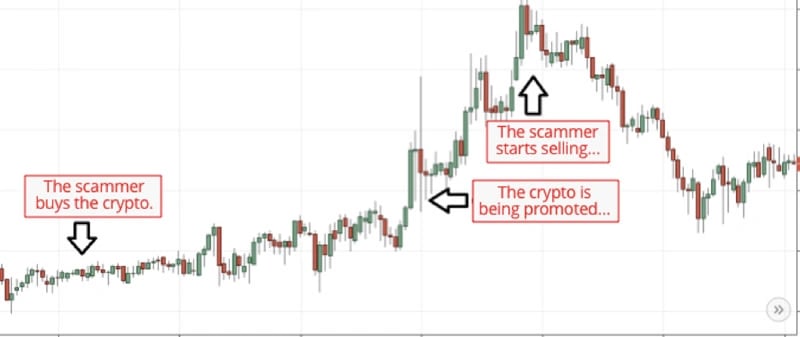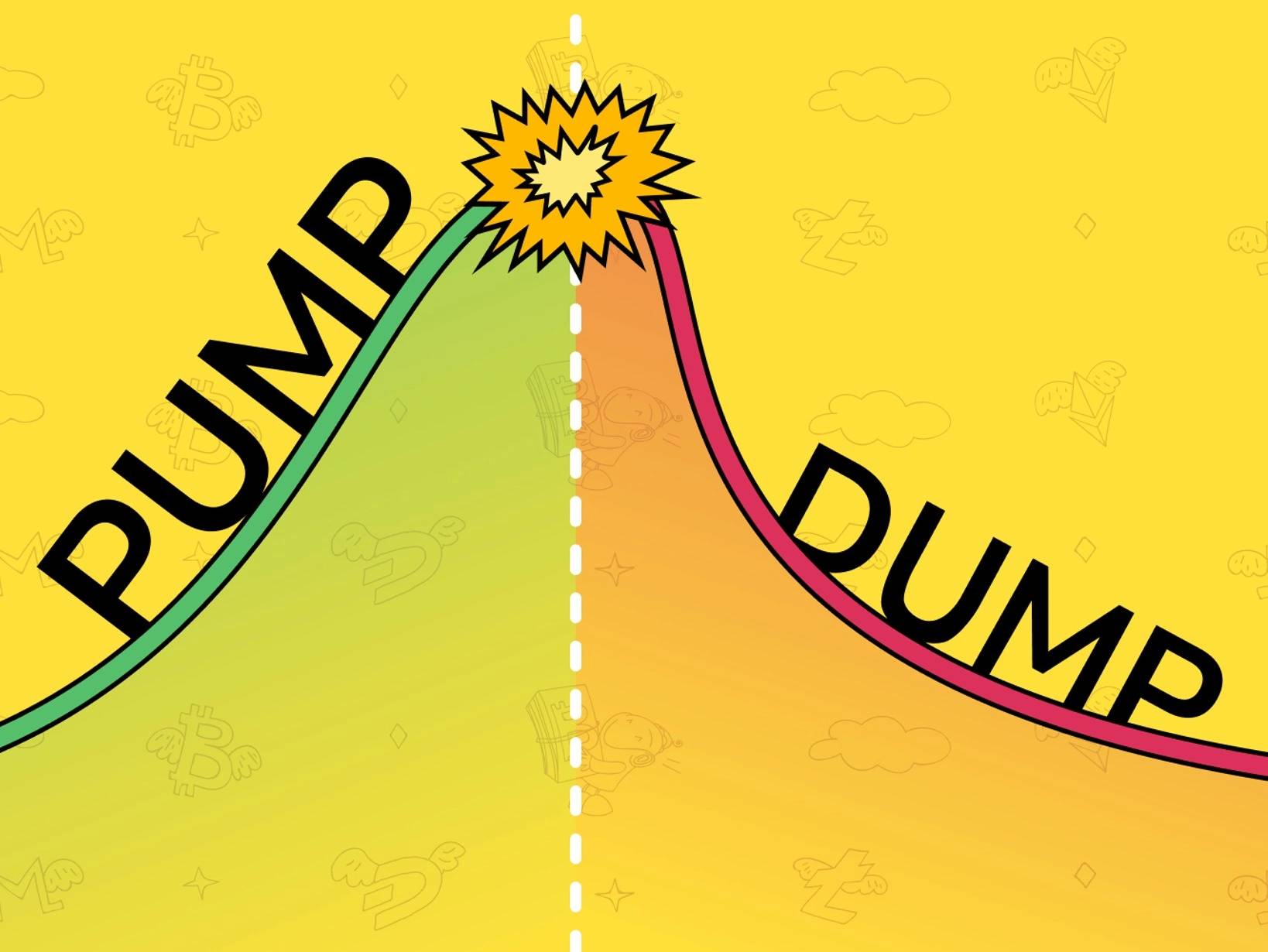위키 구독하기
Share wiki
Bookmark
Pump and Dump
IQ AI를 발표했습니다.
Pump and Dump
**펌프 앤 덤프(P&D)**는 개인이나 단체가 조직적인 매수와 홍보를 통해 암호화폐의 가격을 인위적으로 부풀린 후, 부풀려진 가격에 자신의 보유분을 매도하여 다른 투자자들에게 손실을 안겨주는 조작 계획입니다.[2]
단계

누적 단계
이 단계에서 공격자는 거래량과 가격이 낮은 자산을 선택합니다. 그들은 비교적 저렴한 비용으로 상당량의 자산을 축적하기 시작합니다.[3]
펌핑 단계
사기꾼들이 선택한 자산에 상당한 지분을 축적하면 해당 자산의 잠재력에 대한 허위 또는 과장된 정보를 유포하기 시작합니다. 이러한 정보는 소셜 미디어, 온라인 포럼 등 다양한 채널을 통해 확산됩니다. 점점 더 많은 투자자가 매수에 참여함에 따라 자산에 대한 수요가 증가하고 가격이 급등합니다.
자산의 성공 소식이 퍼지면서, '놓치면 안 된다'(FOMO)는 두려움에 휩싸인 더 많은 투자자들이 행동에 참여합니다. 매수 압력이 증가하면서 가격 인플레이션이 지속되고, 수요가 수요를 부추기는 자기 충족적 예언이 만들어집니다.[3][2]
덤프 단계
자산의 가격이 인위적으로 바람직한 수준까지 상승했을 때, 공격자들은 보유 자산을 매각하기 시작합니다. 이러한 갑작스러운 매도 물량의 급증은 매수 수요를 압도하여 자산 가격의 급격한 하락을 초래합니다. 펌프 단계에서 매수했던 다른 투자자들은 가치가 크게 하락한 자산을 보유하게 됩니다. [1]
P&D 방지
이러한 기법은 암호화폐 및 NFT를 포함한 모든 고유동성 자산에서 널리 퍼져 있습니다. 이러한 활동을 억제하기 위해 규제 기관과 암호화폐 거래소는 비정상적인 거래 패턴 모니터링, 거래 대상 자산에 대한 인식 제고 및 교육, 의심스러운 자산에 대한 거래 중단, 사기 활동과 관련된 계정 정지 등의 조치를 취하여 시장 조작을 감지하고 예방합니다.[6]
최대 P&D 사례와 관련 소송
다양한 경우, 미국 상품선물거래위원회(CFTC)와 증권거래위원회(SEC)는 암호화폐 시장에서 P&D 기법을 포함한 조작적인 거래 관행에 연루된 개인 및 단체에 대해 조치를 취했습니다. 이러한 조치는 일반적으로 벌금 및 법적 제재로 이어집니다.[11]
센트라 테크 (CTR)
- 2017년, 센트라 테크는 비자 및 마스터카드가 지원하는 직불 카드를 제공한다고 주장하며 CTR 토큰에 대한 ICO(Initial Coin Offering)를 실시했습니다.
- 설립자 겸 CEO인 샘 샤르마(Sam Sharma)와 공동 피고인인 로버트 파르카스(Robert Farkas), 레이먼드 트라파니(Raymond Trapani)는 피해자들을 속여 해당 직불 카드 개발에 2,500만 달러 이상을 투자하도록 했습니다. 그들은 가짜 임원, 가짜 사업 파트너십 및 가짜 라이선스를 만들었습니다.
- 그들이 웹사이트에 표시한 홍보 콘텐츠는 허구였으며, CTR 토큰의 가격은 투자를 유치하기 위해 인위적으로 부풀려졌습니다. 이는 '펌프 앤 덤프' 계획의 일부였습니다.
- SEC는 센트라 테크의 ICO와 '센트라 카드'를 홍보한 유명인사인 플로이드 메이웨더(Floyd Mayweather)와 DJ 칼리드(DJ Khaled)를 상대로 소송을 제기했습니다.
- SEC는 센트라 테크에 대해 사기 혐의를 제기했으며, 설립자들은 벌금을 지불하고 일정 기간 동안 증권을 홍보하지 않기로 합의함으로써 혐의를 해결했습니다.
SafeMoon
- 2021년, SafeMoon 설립자 겸 CEO인 Braden John Karony(브레이든 존 캐러니)와 SafeMoon 경영진은 회사와 공개 거래 가능한 상당량의 SafeMoon 디지털 자산에 대한 자기 통제를 공개하지 않고 토큰을 마케팅했습니다.
- SafeMoon 출시 후, 경영진은 Paul, Carter, Soulja Boy, Lil Yachty, Phillips 등 유명인들을 적극적으로 영입하여 Twitter, Reddit, YouTube를 통해 자산 홍보를 했습니다. 대가로 유명인들은 SafeMoon 토큰을 받았습니다.
- 유명인 중심 마케팅 시작 후 9일 만에 SafeMoon 토큰 거래량은 무려 875%나 급증했습니다. 그러나 그 후 10일 동안 거래량은 4월 5일 4,390만 달러에서 4월 15일 890만 달러로 감소했습니다.
- 한편, 2021년 3월 8일 이후 SafeMoon 토큰을 구매한 투자자들은 피고의 '사기성 홍보'로 인해 경제적 피해를 입고 투자 손실을 입었습니다. 이 소송은 SafeMoon 토큰을 구매하고 '러그풀' 시도의 피해자가 된 모든 개인을 대표하고 보상하려는 것입니다.
- Karony는 2021년 4월 SafeMoon이 자체 지갑을 만들 것이라고 약속했지만, 지갑은 출시되지 않았고, 2021년 12월 SafeMoon은 폭락했으며, 경영진과 유명인 홍보자들은 거래량이 부풀려진 사이에 자신의 보유분을 서서히 매각했습니다.
- 이 소송의 대부분은 2월 17일 캘리포니아 중부 지방 법원에 제기되었으며, SafeMoon 토큰의 출시와 소셜 미디어 주도적 상승에서 하락까지를 다루고 있습니다.
McAfee 관련 소송
- 논란의 사이버 보안 선구자 존 맥아피(John McAfee)와 그의 동료들은 맥아피의 트위터 계정을 이용하여 투자 수익이나 홍보 수수료를 통해 이익을 얻을 수 있음을 공개하지 않고 틈새 암호화폐 또는 이니셜 코인 오퍼링을 홍보하여 총 1300만 달러를 벌어들였습니다.
- 맥아피와 그의 동료들은 새로운 암호화폐를 위한 자금 조달 메커니즘인 이니셜 코인 오퍼링 7건을 홍보하기 위해 트위터를 사용했습니다. 맥아피와 그의 팀원들은 해당 ICO들을 트위터에 홍보하는 대가로 이더리움과 비트코인으로 총 1100만 달러와 함께 상당량의 알트코인을 받았다고 합니다.
- 2017년 12월 중순, 그는 동료에게 XVG(버지로도 알려짐) 토큰을 약 5000달러어치 구매하라고 지시했습니다. 같은 날 트위터에서 맥아피는 XVG, 모네로, Zcash를 "절대 손해 볼 수 없는" 코인이라고 설명했습니다. 이틀 후, 한 트위터 사용자가 맥아피가 XVG의 가격을 인위적으로 부풀려 고가에 매도했다고 제안하자, 맥아피는 간단히 "나는 XVG를 소유하고 있지 않다"고 응답했습니다.
- 이 ICO 관련 기소는 2020년 10월 SEC가 맥아피에 대해 제기한 증권 사기 혐의와 일맥상통합니다.
BitConnect
- 2017년, BitConnect(빗코넥트) (BCC)는 34억 달러의 시가총액을 기록했습니다. 그러나 몇 달 만에 가격이 폭락하여 투자자들에게 막대한 손실을 야기했습니다. 미국 법무부(Department of Justice, DOJ)에 따르면, 샌디에이고 연방 대배심은 BitConnect의 '대출 프로그램'(Lending Program)을 통해 상당한 이익과 확정 수익을 보장한다는 허위 광고로 폰지 사기 계획을 주도한 혐의로 Kumbhani를 기소했습니다.
- BitConnect 설립자 Satish Kumbhani는 전 세계 투자자들을 속이고 24억 달러를 사취한 혐의를 받고 있습니다.
- 기소장에는 또한 Kumbhani가 은행 비밀법(Bank Secrecy Act)에 따라 요구되는 금융범죄단속네트워크(Financial Crimes Enforcement Network, FinCEN)에 등록하지 않음으로써 미국 규정을 회피했다는 주장도 포함되어 있습니다.
- Kumbhani는 전신 사기 공모, 상품 가격 조작, 무허가 송금업체 운영, 국제 자금 세탁 공모 혐의를 받고 있습니다.
각국의 법률
펌프앤덤프 기법 및 기타 시장 조작을 방지하기 위해 노력하는 기관은 일반적으로 금융 감독 기관입니다. 기관의 정확한 명칭은 국가마다 다릅니다. 펌프앤덤프 기법을 감시하고 조치를 취하는 여러 국가의 감독 기관 중 일부는 다음과 같습니다.
미국
- 미국 증권거래위원회 (SEC):
증권 또는 증권으로 간주되는 토큰을 포함하는 펌프 앤 덤프 계획은 연방 증권법의 적용을 받습니다. SEC는 P&D 계획을 포함한 사기 활동에 대해 엄격한 입장을 취하며, 이러한 계획에 연루된 개인 및 단체에 대해 민사 집행 조치를 취할 수 있습니다.
- 미국 상품선물거래위원회 (CFTC):
계획에 상품 또는 파생상품이 포함된 경우 CFTC도 개입하여 집행 조치를 취할 수 있습니다.
캐나다
- 캐나다 증권 관리자 협회 (CSA):
캐나다는 CSA 회원인 각 주 및 준주 증권 규제 기관을 두고 있습니다. 증권이 관련된 P&D 계획은 이들의 관할권에 속합니다. CSA 회원은 사기 활동에 연루된 개인이나 단체에 대해 법적 조치를 취할 권한이 있습니다.
영국 (Yeongguk)
- 금융행위감독청 (FCA, Geumyunghaengwi Gamdokcheong):
FCA는 영국의 금융 시장을 감독하는 규제 기관입니다. FCA는 암호화폐 분야의 P&D 활동을 포함한 사기 계획에 연루된 자에 대해 조사하고 법적 조치를 취할 권한을 가지고 있습니다.
유럽 연합
- 유럽증권시장감독청 (ESMA):
ESMA는 EU 내 금융 시장 규제를 조정합니다. 회원국들은 자체 규제 기관을 보유하고 있으며, P&D 계획에 대한 조치는 다를 수 있지만, 투자자 보호를 위해 EU 전역 규정 및 지침이 적용될 수 있습니다.
오스트레일리아
- 오스트레일리아 증권투자위원회 (Australian Securities and Investments Commission, ASIC):
ASIC은 오스트레일리아의 금융 규제 기관입니다. 증권 및 금융 상품과 관련된 사기 행위에 연루된 개인이나 단체에 대해 조사하고 법적 조치를 취할 권한이 있습니다.
일본
- 금융청 (FSA):
일본의 금융청은 암호화폐 거래소를 포함한 금융 시장을 감독합니다. 암호화폐 관련 P&D 기법은 일본 법에 따라 처벌받을 수 있습니다.
대한민국 (Daehanminguk)
- 금융위원회 (FSC, Geumyungwiwonhoe):
대한민국의 금융위원회는 암호화폐 거래소를 포함한 금융 시장을 감독합니다. 금융위원회는 P&D 기법을 포함한 불법 행위에 대해 조사하고 법적 조치를 취할 권한이 있습니다.
중국
- 중국인민은행 (PBOC):
중국은 암호화폐에 대해 엄격한 입장을 취하고 있으며, P&D 기법 및 기타 사기 행위를 방지하기 위한 조치를 시행하고 있습니다. 중국에서는 암호화폐 거래와 ICO가 금지되어 있습니다.
정부 대응
정부 및 규제 당국은 암호화폐 시장을 포함한 금융 시장에서의 P&D 기법에 대응하기 위해 다양한 조치를 취하고 있습니다. 이러한 조치는 투자자를 보호하고 시장의 무결성을 유지하며 법치를 수호하기 위해 고안되었습니다.
정부 및 규제 기관이 P&D 기법에 대응하여 취하는 일반적인 조치는 다음과 같습니다:[10]
민사 및 형사 집행
정부는 P&D 계획에 연루된 개인 및 단체에 대해 민사 또는 형사 집행 조치를 취할 수 있습니다. 이러한 조치는 사기 행위로 유죄 판결을 받은 사람들에게 벌금, 징벌, 심지어 징역형을 초래할 수 있습니다.
자산 동결
P&D 가해자들이 그들의 계획으로부터 이익을 얻은 경우, 정부는 법원 명령을 통해 그들의 자산을 동결하려 할 수 있습니다. 이는 개인이나 단체가 불법적으로 얻은 이익을 없애는 것을 방지하기 위해서입니다.
규제 경고 및 알림
규제 기관은 종종 공개 경고 및 알림을 발표하여 투자자들에게 알려진 또는 의심되는 주가 조작 계획(Pump and Dump, P&D)에 대해 알립니다. 이러한 경고는 대중을 교육하고 사기 활동 참여를 막는 것을 목표로 합니다.
국제 당국과의 공조
P&D 계획은 범죄자와 피해자가 국경을 넘나들며 관련될 수 있으므로 국제적인 범위를 가질 수 있습니다. 정부는 외국 규제 기관 및 법 집행 기관과 공조하여 범죄자를 조사하고 기소할 수 있습니다.
강화된 규제 프레임워크
암호화폐 시장에서 P&D 기법과 같은 새로운 위협에 대응하여 정부는 디지털 자산 및 관련 활동에 대한 감독을 강화하기 위해 규정을 제정하거나 개정할 수 있습니다. 여기에는 등록, 보고 및 자금세탁방지 (AML) 및 고객확인제도 (KYC) 규정 준수 요건이 포함될 수 있습니다.
교육 활동
규제 당국은 종종 P&D 계획과 관련된 위험에 대한 인식을 높이고 이러한 계획의 피해자가 되는 것을 피하는 방법에 대한 지침을 제공하기 위해 교육 활동에 참여합니다.
잘못된 내용이 있나요?
